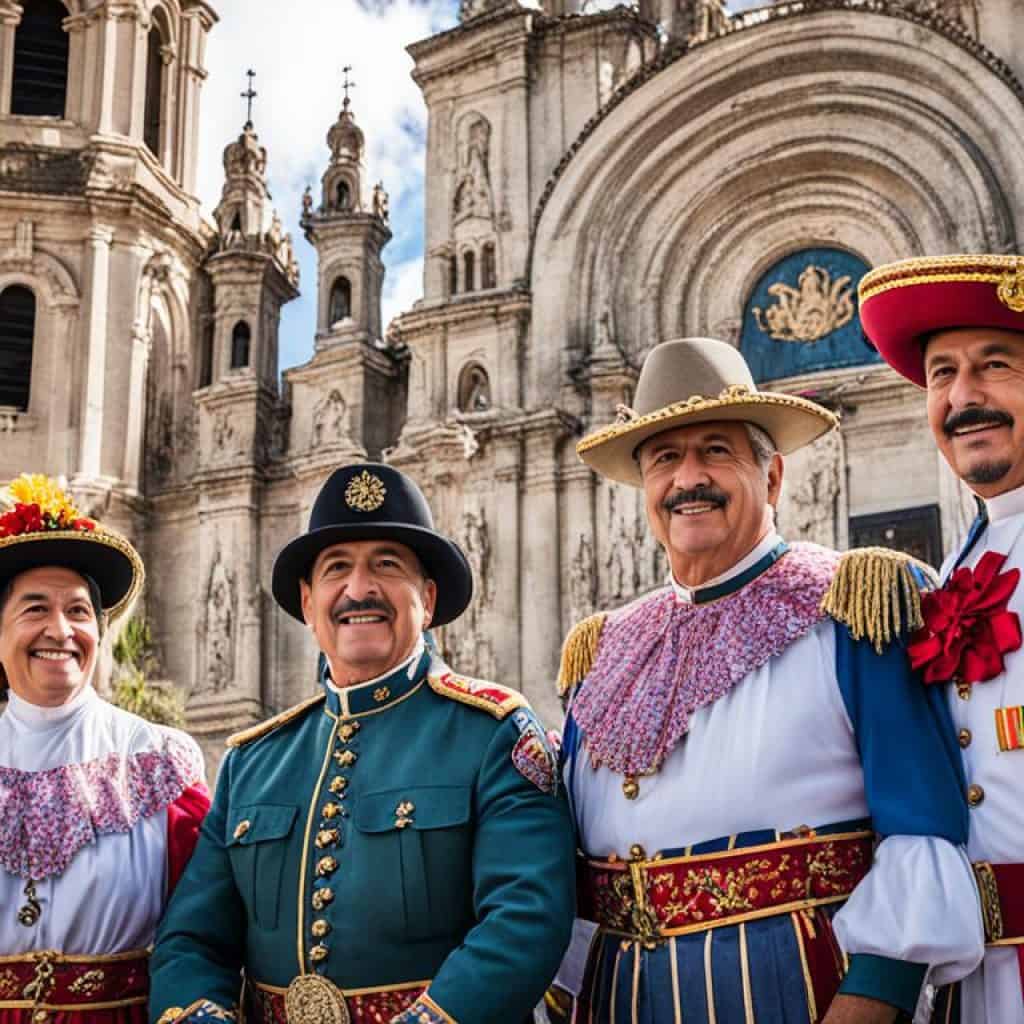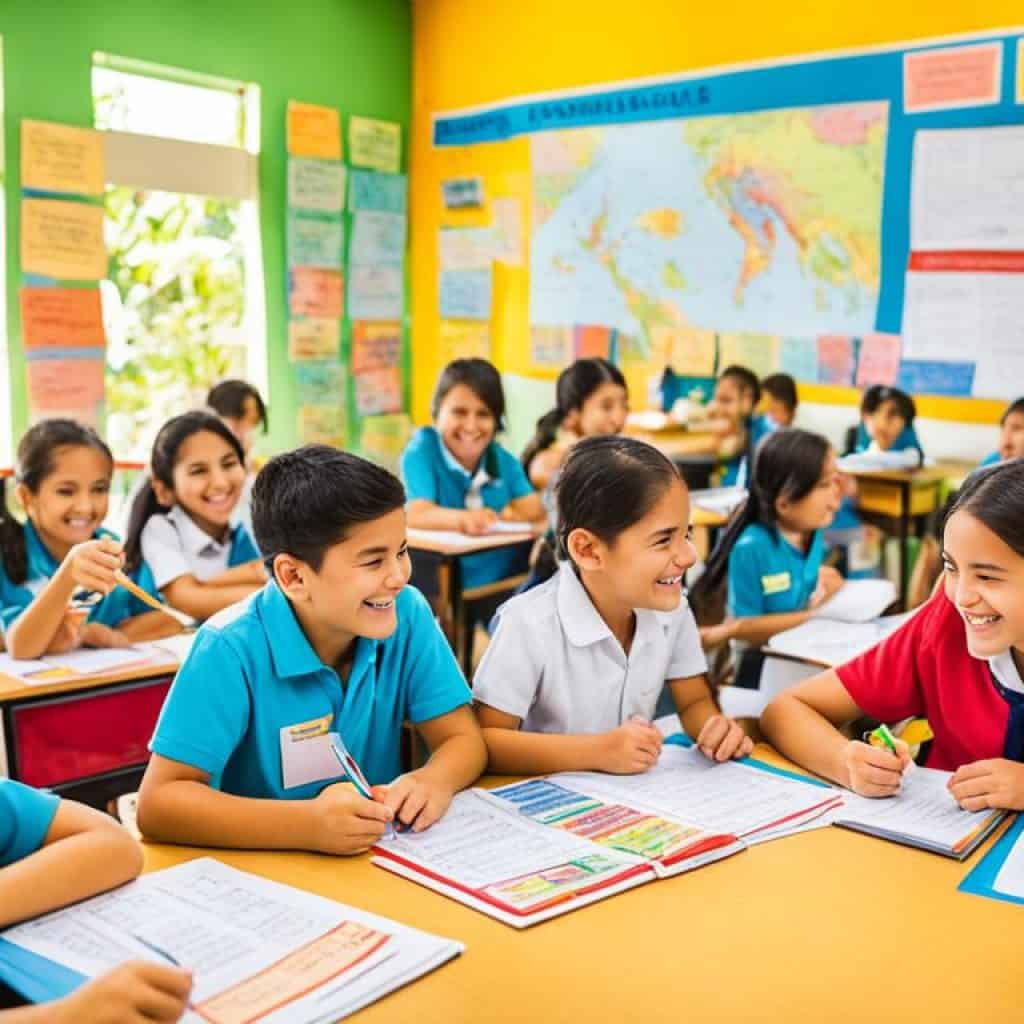Did you know the Philippines has two official languages? This fact highlights the country’s diverse linguistic landscape. It also shows how important language is to Filipinos.
In the Philippines, Filipino and English are widely used. The country is home to 120 to 187 spoken languages. This diversity shows its rich culture and history.
Key Takeaways:
- The Philippines has two official languages, Filipino and English.
- Filipino serves as a lingua franca across much of the country.
- The linguistic landscape has been shaped by colonization, particularly Spanish and American influences.
- Tagalog, a widely spoken language, was the official language from 1937 to 1987.
- Efforts are being made to preserve and revitalize endangered languages in the Philippines.
The Role of Colonization in Language Adoption in the Philippines
The Philippines’ languages were deeply shaped by colonial powers. Spanish and English have had a big impact on the nation’s language policy and diversity.
Spanish Influence
The Philippines was under Spanish control for over 300 years. This led to Spanish being widely used in government, education, religion, and trade. Its effect is still seen today, especially in loan words in Filipino.
The Introduction of English
The U.S. brought English to the Philippines during their occupation. It was used in schools and seen as a path to modernization. English became crucial in government, education, and trade, marking its significance in the Philippines.
The Adoption of Filipino
In 1937, the Philippines declared Filipino as its national language. Based on Tagalog, it aimed to unite the country’s diverse languages and regions. Filipino is now a key language for communication and an official language alongside English.
“The adoption of Filipino as the national language aimed to unify the linguistically diverse country.”
Choosing Filipino as the national language was a step towards preserving culture and boosting unity. It shows the importance of a shared language for communication and governance. This decision highlighted the country’s dedication to unity and its rich linguistic variety.
Language policy in the Philippines has changed due to colonization and history. Both Spanish and English have left their mark on the nation’s linguistic landscape.
| Period | Languages of Influence |
|---|---|
| Spanish Colonial Period | Spanish |
| American Colonial Period | English |
| Modern Era | Filipino and English |
What Is Tagalog?
Tagalog is one of the Philippines’ official languages, spoken by many Filipinos. It was the country’s official language between 1937 to 1987. Today, it still has a strong influence. Tagalog is closely related to Filipino, the country’s other official language.
Tagalog and Filipino have many similarities because Filipino is mainly based on Tagalog. Filipino allows Filipinos from different regions to communicate effectively with each other.
“Tagalog is a rich and expressive language that reflects the cultural heritage and identity of the Filipino people.”
Tagalog originated in Luzon’s Tagalog region, the Philippines’ largest island. It’s known for its melodic rhythm and poetic expressions. The language offers a rich vocabulary and complex grammar for deep communication and cultural connection.
Tagalog vs. Filipino: What’s the Difference?
Tagalog and Filipino are similar but have key differences. Tagalog is the language of the Tagalog region. Filipino, however, is wider in scope, blending multiple languages and dialects from across the Philippines. Filipino is based on Tagalog but also includes elements from other languages, making it more representative of the whole country.
Filipino became an official language to promote national unity and understanding. It celebrates the Philippines’ linguistic diversity by including various regional languages.
The Importance of Tagalog and Filipino
Tagalog and Filipino are vital to the Philippines’ cultural and social landscape. They support clear communication and help build a national sense of identity. These languages are crucial in education, media, literature, and in preserving Filipino heritage.
The linguistic richness of Tagalog and Filipino adds to the Philippines’ multicultural identity. They uniquely represent the Filipino people.
The Most Spoken Native Filipino Languages
The Philippines is known for its rich linguistic diversity, with numerous native languages spoken throughout the country. These languages, each with its own unique characteristics, contribute to the cultural tapestry of the Filipino people.
Among the most widely spoken native languages in the Philippines are:
- Tagalog: With the most native speakers, Tagalog is the primary language of the capital region and surrounding areas. It is closely related to other Filipino languages and serves as the foundation for the national language, Filipino.
- Cebuano: Also known as Bisaya, Cebuano is spoken by a significant number of individuals across various regions in the Philippines, particularly in the Visayas and Mindanao. It has earned recognition as one of the most widely spoken languages in the country.
- Ilocano: Predominantly spoken in the northern part of Luzon, Ilocano is the third most spoken language in the Philippines. It has a rich literary tradition and is widely used in the Ilocos Region.
- Hiligaynon: Known for its distinct rhythm and intonation, Hiligaynon is prevalent in the Western Visayas region, particularly in the province of Iloilo. It is often called Ilonggo.
- Waray: Spoken primarily in the Eastern Visayas region, Waray is a language with a strong poetic tradition. It is commonly used in the provinces of Samar and Leyte.
These native languages reflect the cultural diversity and regional identities of the Filipino people. They serve as vehicles for communication, connecting communities and preserving their unique heritage.
| Native Language | Region | Approximate Number of Native Speakers |
|---|---|---|
| Tagalog | National Capital Region, Luzon | 22 million |
| Cebuano | Visayas, Mindanao | 20 million |
| Ilocano | Ilocos Region, Cordillera Administrative Region | 7 million |
| Hiligaynon | Western Visayas | 4.5 million |
| Waray | Eastern Visayas | 3 million |
These figures are approximate estimates, as language use and proficiency may vary across different sources and regions.
Despite the prominence of these native languages, Filipino and English remain important languages in various domains of Filipino society, including education, media, government, and business. Understanding the linguistic landscape of the Philippines is essential to appreciating its diverse culture and heritage.
Spanish in the Philippines
Spanish played a big role in the Philippines’ history, being the main language for centuries. It came with colonization and spread across the islands. It was the language of most aspects of life. Spanish words are still part of the Filipino language today.
Today, not many people in the Philippines speak Spanish. But, its effect on Filipino culture is strong. Spanish influences are seen in phrases, food names, and traditions.
“Spanish is not just a foreign language, but an integral part of our own.” – Ambeth Ocampo
In everyday talk, you can hear Spanish words like “kamiseta” for shirt, “mesa” for table, and “silya” for chair. This mix of languages shows the Philippines’ rich history with Spain.
Influence on Language and Culture
The Spanish language also affected Filipino culture. It helped create a unique culture seen in music, dance, and festivals. An example is the “Sinulog” festival in Cebu.
New art, religious practices, and buildings came with Spanish rule. Famous Spanish-era churches, like Paoay Church, are still important today. They show the mix of cultures.
Many Filipino surnames are Spanish, thanks to the colonial period. These names link the Philippines and Spain’s history.

Echoes of the Past
Spanish is used less now, but the push to keep it alive is strong. Groups like Instituto Cervantes and the Spanish Embassy offer programs to honor the shared history of Spain and the Philippines.
The lasting Spanish effect shows the diverse language heritage of the Philippines. It’s a sign of how the country has blended Spanish culture into its own. The Filipino spirit of merging influences shines through.
“Languages, like cultures, grow and change through time. What is important is that we treasure and celebrate the richness of our linguistic heritage.” – Ramon Guillermo
| Spanish Influence in the Philippines | Examples |
|---|---|
| Vocabulary | “Calle” (street), “adios” (goodbye), “gracias” (thank you) |
| Food | “Lechon” (roast pig), “paella” (saffron rice dish), “churros” (fried dough pastry) |
| Traditions | Sinulog Festival, Flores de Mayo (May Flower Festival) |
| Architectural Style | Paoay Church, Miagao Church |
English in the Philippines
English is very important in the Philippines. It is used in schools, business, government, and media. Many people in the Philippines speak English well. This has made the country known for its English skills.
Being good at English has helped the Philippines a lot. It has made the economy better. It has also helped Filipinos get jobs all over the world. This lets them show their skills on a global stage.
Learning English is key in the Philippines. It is a big part of schooling there. This helps students succeed later in life. English helps in business too, making it easier to work with people from other countries.
“English proficiency has become not only a means of communication but also a symbol of competence and upward mobility in the Philippines.”
English is used by many people in the Philippines. Professionals, teachers, and everyday people speak it. Being good at English is an advantage in the job market.
English also connects the Philippines with other countries. It helps with trade and sharing ideas. English in media and entertainment shares Filipino stories globally.
English Proficiency Index
The Philippines is known for its English skills. According to the EF English Proficiency Index, it’s often in the top 20. This shows the country’s strong focus on English education.
| Year | Ranking |
|---|---|
| 2021 | 27 |
| 2020 | 27 |
| 2019 | 20 |
This ranking shows the country’s dedication to teaching English. It shows how important English is in the Philippines for global relations.
In summary, English is very important in the Philippines. It is used in many areas of life there. The country’s strong English education and the people’s fluency have made it well-known for English. English helps the Philippines connect with the world and share its culture.
Unofficial and Endangered Languages in the Philippines
The Philippines is home to many languages beyond its official ones. It has a rich collection of languages spoken by certain communities or indigenous groups. These languages are in danger of vanishing. Let’s look at a few examples of these unique languages:
- Cebuano: Also known as Bisaya or Visayan, Cebuano is widely spoken in the Visayas and Mindanao. It has a vibrant literary tradition, making it one of the country’s major languages.
- Ilocano: Mainly spoken in the Ilocos Region and parts of Central Luzon, Ilocano boasts a rich history. Its poetic oral tradition is well-known.
- Kapampangan: Kapampangan, from Pampanga province and Central Luzon, stands out with its unique sound and words. Despite fewer speakers, efforts aim to keep this language alive.
- Pangasinan: Native to Pangasinan province, Pangasinan has a special literary tradition. It’s recognized as a major language in the Philippines.
- Maranao: From the Lanao provinces in Mindanao, Maranao is the language of the Maranao people. It’s famed for its beautiful literature and rich cultural traditions.
These examples show the unofficial languages that enrich the Philippines’ linguistic diversity. Each one has its own culture, traditions, and stories. They help tell us who we are.
“Languages are the foundations of cultures, and their preservation is vital for maintaining the diversity and richness of our world.” – Linguist Jane Doe
Unofficial languages are under threat due to various factors. Dominant languages, urbanization, and globalization challenge their existence. Language advocates and community groups are fighting for these languages to survive.
Preservation Efforts and Initiatives
In the Philippines, many organizations and cultural groups work to save endangered languages. They are involved in various initiatives:
- They set up schools and programs to teach and celebrate endangered languages.
- They work on projects to document languages, creating dictionaries and written resources.
- They partner with indigenous communities to revive and preserve ancestral languages.
- They help bring indigenous languages into popular culture, like movies and music.
These initiatives are key to keeping these languages alive. They not only save cultural heritage but also add to the Philippines’ rich tapestry of languages.
The Linguistic Diversity of the Philippines
The Philippines is known for its many languages. It has between 120 to 187 languages. This shows the country’s rich culture and different areas.
The wide range of languages comes from its many indigenous communities and regions. Each language is a special part of the Philippines’ identity.
The country has both widely spoken languages like Tagalog and lesser-known ones like Kapampangan. This variety shows the many sides of the Philippines.
There are also indigenous languages from different ethnic groups. These languages carry history and traditions. They are passed down through generations.
Cultural Significance of Language
Language is very important in the Philippines. It’s not just for talking; it represents the identity and history of Filipino communities. It is linked with traditions and arts.
“Language is the roadmap of a culture. It tells you where its people came from and where they are going.” – Rita Mae Brown
Philippines’ languages bring pride and unity among its people. By keeping these languages alive, Filipinos protect their culture for the future.
The Unique Identity of the Filipino People
The many languages in the Philippines help shape its people’s unique identity. Each language stands for a different area or group. They add to the country’s diverse population.
This variety encourages acceptance. It lets people feel part of their community. It celebrates the many cultures, beliefs, and stories in the Philippines.
Linguistic Diversity Table
The table below shows some major languages in the Philippines:
| Language | Region | Number of Speakers |
|---|---|---|
| Tagalog | Central Luzon, Metro Manila | 24 million |
| Cebuano | Visayas, Mindanao | 21 million |
| Ilocano | Ilocos Region, Cordillera Administrative Region | 7.7 million |
| Hiligaynon | Western Visayas, SOCCSKSARGEN | 7.5 million |
| Waray | Eastern Visayas | 3.1 million |
The Philippines’ many languages show its cultural richness. They also bring the country together. These languages help define the Filipino people and add to the Philippines’ culture.
Language Education in the Philippines
In the Philippines, language education is key for good communication. It also promotes understanding of different cultures. The nation values its two official languages, Filipino and English. Schools focus on teaching these.
Filipino, or Tagalog, is a school subject. It helps students learn their national language well. This bond people from various backgrounds together.
English is used to teach many subjects. Starting young, students learn to speak English fluently. Being good at English is beneficial. It helps with school and job chances in the country and abroad.
The goal of language learning in the Philippines is broad. It aims to improve speaking, listening, reading, and writing in Filipino and English. This method prepares students well for different areas in life.
“Language education in the Philippines helps students speak well and be sensitive to cultural differences. It celebrates the country’s diversity.”
There are efforts to keep indigenous languages alive. Programs encourage the use and teaching of these languages in native communities. This protects their culture and makes sure these languages stay alive and well.

Cultural Significance of Language in the Philippines
Language in the Philippines is very important. It shows the variety of cultures and identities in Filipino communities. It helps keep traditions, art, literature, and music alive. Language shapes the way Filipinos live, think, and interact with each other.
Language helps keep cultural heritage alive. Indigenous languages hold history and unique stories. They tell of traditional beliefs, folklore, and tales. Language connects us to our ancestors. It helps pass down cultures to new generations.
“Language is the carrier of cultural heritage. It is the vessel that carries our stories, our traditions, and our identity as a people.”
Many languages are spoken in the Philippines, each showing pride and connection. Speaking one’s native language strengthens their ties to their roots and community. It fosters a sense of belonging.
Language is key in Filipino arts and literature. It helps artists share creativity, thoughts, and feelings. Filipino literature features the country’s culture, legends, and life. Each language adds its own beauty to the stories told.
Music in the Philippines is also shaped by language and culture. Different languages bring different musical styles. These reflect the culture of their region. Language in music shares stories, making songs about love, joy, and strength.
Cultural Language Preservation Efforts
There are efforts to keep languages alive in the Philippines. Preservation programs and community groups work to save indigenous languages. They want to make sure the Philippines’ rich languages remain vibrant.
Language is crucial in connecting Filipinos to their heritage. It shapes their lives and safeguards the future. By appreciating the country’s linguistic diversity, the Philippines honors its rich culture. This builds a strong national identity rooted in tradition.
Language and Identity in the Philippines
Language shapes identities in the Philippines. The country is home to many languages and dialects. Each one reflects a unique culture. Tagalog, Cebuano, and Ilocano. These are not just for talking. They show pride and create a sense of belonging.
Languages weave together the Filipino identity. This mix makes society vibrant and welcoming. Different languages allow people to celebrate their heritage. Through them, traditions stay alive and cultures are expressed.
Take Tagalog, it’s more than a language in Luzon. It’s a source of pride. It connects people to their roots. Cebuano and Ilocano are just as important. They add richness to the Filipino identity.
Language is not just a means of communication; it is the soul of a people, a reflection of their history, values, and aspirations.
Multilingualism in the Philippines promotes diversity. It brings people together. Filipinos learn to cherish different languages and cultures. This diversity builds bridges and fosters unity in the country.
Art and literature in the Philippines capture the essence of its languages. Artists and writers get inspiration from their linguistic heritage. Their work shows the Filipino experience. The nation’s culture is rich and complex, just like its many languages.
Language Challenges and Preservation Efforts in the Philippines
The Philippines has a rich tapestry of languages. This diversity is its cultural treasure. But it comes with challenges for keeping languages alive. Filipino and English, urban growth, global influences, and fading indigenous tongues are hurdles to overcome.
Firstly, Filipino and English dominate many aspects of life in the Philippines. They’re crucial in schools, government, and business. But they can push aside other native tongues. This could lead to some languages being used less, risking their existence and decreasing cultural variety.
Urbanization and globalization also threaten language survival. As cities grow and the modern world spreads to isolated areas, the youth might favor Filipino and English. They may think these languages offer better job chances. This could weaken the role of native languages in everyday life and the future.
There are efforts to save and celebrate endangered languages in the Philippines. Schools, government bodies, and cultural groups are working to make people aware of these languages’ value. They also encourage their usage. Additionally, community actions and local movements help by giving speakers a place to pass on their language and culture.
Cultural places like museums, libraries, and archives are key in keeping languages alive. They gather stories, writings, and language studies. These resources ensure that future generations can learn about their linguistic and cultural heritage.
We must work together to save the Philippines’ languages. It’s a team effort involving everyone. It requires ongoing commitment to highlight the worth of native languages. Our goal is to preserve them for the future.
| Language Challenges in the Philippines | Preservation Efforts |
|---|---|
| The dominance of Filipino and English | Language preservation programs |
| Urbanization and globalization | Community initiatives and grassroots movements |
| Decline of indigenous languages | Cultural institutions preserving linguistic resources |
Conclusion
The Philippines is a land of many languages, with Filipino and English as its main ones. The country’s history of being colonized, especially by Spain and the USA, plays a big role. Tagalog and Filipino are key, but many other local languages add to its language mix.
Spanish and English have left a big mark on the Philippines. Spanish was once the official language, and now English is important for school, work, and government. Keeping indigenous languages alive and teaching them is key to protect the culture and identity of the Filipino people.
In summary, the Philippines has a rich language history. Filipino and English lead, but many other local languages are also important. Working to save native languages and teach them is essential. It helps keep the Philippines’ unique language landscape alive.







Add comment